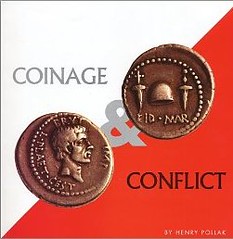
About UsThe Numismatic Bibliomania Society is a non-profit organization promoting numismatic literature. For more information please see our web site at coinbooks.org SubscriptionsThose wishing to become new E-Sylum subscribers (or wishing to Unsubscribe) can go to the following web page link MembershipThere is a membership application available on the web site Membership Application To join, print the application and return it with your check to the address printed on the application. Membership is only $15 to addresses in the U.S., $20 for First Class mail, and $25 elsewhere. For those without web access, write to: David M. Sundman, Secretary/TreasurerNumismatic Bibliomania
Society AsylumFor Asylum mailing address changes and other membership questions, contact David at this email address: dsundman@LittletonCoin.com SubmissionsTo submit items for publication in The E-Sylum, just Reply to this message, or write to the Editor at this address: whomren@coinlibrary.com
BUY THE BOOK BEFORE THE COINYou won't regret it! |
- WAYNE'S WORDS: THE E-SYLUM JUNE 27, 2010
- ANA CONVENTION EXHIBIT APPLICATIONS DUE JULY 1, 2010
- NBS WILL NOT HAVE A CLUB TABLE AT THE BOSTON ANA CONVENTION
- NEW BOOK: HISTORY OF OTTOMAN COINS (VOLUME II) BY DAMALI
- BOSTON NUMISMATIC SOCIETY 150TH ANNIVERSARY REDBOOK
- BOOK REVIEW: ASTRONOMICAL SYMBOLS ON ANCIENT AND MEDIEVAL COINS
- THE UNITED STATES BRANCH MINT AT DENVER, COLORADO TERRITORY
- JUDGE JAMES P. GORTER MEDALLION FOUND
- SHIP OF GOLD EXHIBIT TO DOCK AT BOSTON ANA CONVENTION
- PUBLICATIONS OF THE COIN AND CURRENCY INSTITUTE
- NUMISMATIC VOCABULARY: BORDERS, RIMS AND EDGES
- RERUN: HISTORY DETECTIVES TACKLE PURPORTED ANNIE OAKLEY COIN
- CHARLOTTE BRANCH MINT INFORMATION IN THE 1913 MINT REPORT
- QUERY: TOTAL NUMBER OF DIFFERENT REGULARLY MINTED U.S. COINS
- MORE BASHLOW CONFEDERATE COIN RESTRIKE SIX-COIN SETS
- RICHARD MARGOLIS ON THE CHASE MANHATTAN MONEY MUSEUM
- 1794 DOLLAR OWNER MARTIN LOGIES INTERVIEWED
- SO WHAT IS THIS STRANGE 'GOOD LUCK' SYMBOL?
- NOTES FROM E-SYLUM READERS: JUNE 27, 2010
- LOREN GATCH ON BIG GOLD COINS
- WHY CHINA'S CURRENCY HAS TWO NAMES: YUAN AND RENMINBI
- WHY NAILS ARE MEASURED IN PENNIES
- FEATURED WEB SITE: UNIVERSITY OF VIRGINIA NUMISMATIC COLLECTION
WAYNE'S WORDS: THE E-SYLUM JUNE 27, 2010

Among our new subscribers this week is Neil Aitchison. Welcome aboard! We now have 1,358 subscribers.
Our family had a wonderful trip to Hershey Park this week, and even Hannah rode most of the roller coasters. We're thinking about New York City for another family excursion - Dee and the kids have never been there. Recommendations and suggestions are welcome; is there such a things as an affordable, family-friendly place for a party of seven to stay in the city? And how do you get around with a group that large - hail two cabs every time?
This week we open with a reminder of the impending deadline for exhibit applications at the upcoming ANA convention in Boston, followed by an update from Howard Daniel, information and reviews on three numismatic books and a sneak peek at Larry Lee's upcoming book on Colorado gold coins based on the Frederick Mayer collection.
Other topics this week include the S.S. Central America "Ship of Gold" exhibit, publications of the Coin & Currency Institute, and the different names for Chinese currency. To see your Editor get slapped upside the head, and learn about runic symbols in numismatics, read on. Have a great week, everyone!
Wayne Homren
Numismatic Bibliomania Society
ANA CONVENTION EXHIBIT APPLICATIONS DUE JULY 1, 2010
IMPORTANT REMINDER: Exhibit applications for the American Numismatic Association's 2010 ANA World's Fair of Money, Boston – August 10 - 14 are due by July 1, 2010. The next few days are crucial for E-Sylum readers wishing to set up a display of numismatic literature at the convention.
We've had some great literature exhibits at past conventions. The Numismatic Bibliomania Society endowed the exhibit category with a $3,000 donation to the ANA. Let's have a great selection of exhibits this year!
For an exhibit application, see:
www.worldsfairofmoney.com/assets/files/Exhibits
/Exh%20Applicationfinal%20050310.pdf
By the way, the convention is a GREAT time to take the ANA Judge's Certification program. It's a great way to learn how exhibits are judged, and that can only help make you a better exhibitor. I did it one year, and I'm glad I did. For more information, contact Sam Deep at DeepSam@aol.com .
For links to exhibit rules and the judging schedule, see www.worldsfairofmoney.com/index.php?id=55
NBS WILL NOT HAVE A CLUB TABLE AT THE BOSTON ANA CONVENTION
I was recently informed that my club table/booth at the American Numismatic Association events will now cost $100 to cover their costs. This is not a problem for me because I have been a Patron for $100 for most of their events, but I have been a little concerned because we "minor" Patron donors have recently not been getting noticed at the events.
I was also informed that that my Boston club table would be on the midway/concourse and not on the bourse. Whenever I have had a club table on a midway/concourse, it has been a waste of time. The event attendees want to quickly get on the bourse and bypass the club tables, and when they leave, they are ready to go home and also bypass the club tables.
I told the ANA that I would not be using a club table in Boston, but I would still assist with the Philippine Collectors Forum on Friday and moderate my Numismatics International (NI) and International Bank Note Society (IBNS) meetings on Saturday. And I can put some materials out for NBS and the other organizations I support on the information tables at the entrance to the bourse.
E-Sylum readers will not see me at a table as usual, but they can page me and come to my meetings, if they wish to talk to me.
Information on other planned NBS events at the convention were published in the latest issue of our print journal, The Asylum, and I'll provide updates here in The E-Sylum over the next few weeks. -Editor
NEW BOOK: HISTORY OF OTTOMAN COINS (VOLUME II) BY DAMALI
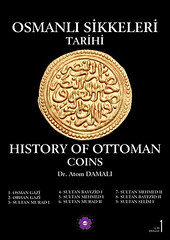

Athens Numismatic Museum, one of the major museums of our neighbour Greece, gave support to Nilüfer Damali Education Foundation's project which aims to create an inventory of and classify the entire attainable Ottoman coins.
Athens Numismatic Museum was one of the points of calls along the Ottoman coin studies conducted in numerous museums and private collections. Yorka Nikolaou and Panagiotis Kokkas from the Athens Numismatic Museum assisted Dr. Atom Damali in his intensive researches. By granting Turkey its rare coins collection housed solely in Athens Numismatic Museum, the museum has also been exemplar to the cultural collaboration between the two nations.
Dr. Atom Damali stated that the fact Ottoman coins, struck in 130 different mints of various countries, were also issued in Chios, Thessalonica, Sidrekapsi (Siderocausa), Siroz (Serres) and Yenishehir, the 5 cities of Greece, is an embodiment of the historical common culture between Greece and Turkey.
This project, which will assemble the entire Ottoman coins under 8 separate volumes, is expected to be completed by the end of 2011. The revenue gathered from the sales of the book (project) is donated for the education of blind students in Turkey. The book History of Ottoman Coins can be obtained from the website www.niluferdamalivakfi.org .
To read the earlier E-Sylum article, see: NEW BOOK: HISTORY OF OTTOMAN COINS BY DAMALI (www.coinbooks.org/esylum_v12n51a06.html)
BOSTON NUMISMATIC SOCIETY 150TH ANNIVERSARY REDBOOK
 This year the Boston Numismatic Society is celebrating its 150th anniversary marking it as one of the oldest United States groups dedicated to the study and enjoyment of coin collecting. Such an event deserves the attention and appreciation of all of us with kindred interests. It is rare achievement. The BNS has not only been a consistent leader in numismatic accomplishments, but has been an inspiration to countless other organizations that have followed in its footsteps.
This year the Boston Numismatic Society is celebrating its 150th anniversary marking it as one of the oldest United States groups dedicated to the study and enjoyment of coin collecting. Such an event deserves the attention and appreciation of all of us with kindred interests. It is rare achievement. The BNS has not only been a consistent leader in numismatic accomplishments, but has been an inspiration to countless other organizations that have followed in its footsteps.
Throughout the years the BNS membership has included many well known personalities that have contributed to the literature and advancement of numismatic knowledge. Some of the more prominent are Sylvester S. Crosby, William Sumner Appleton, Howland Wood, Malcolm Storer, Shepard Pond, James Clapp, Cornelius C. Vermeule and George Fuld.
In celebration of this historic event the BNS has issued a medal and will also be the host club for the upcoming ANA World's Fair of Money© convention that is being held August 10-14, in Boston at the Hynes Convention Center. The sponsoring committee also managed issuing a special commemorative issue of the Guide Book of United States Coins (the 2011 Red Book).
Under the leadership of bibliophile Charles Davis, and through the cooperation of Whitman Publishing Company, a very special limited edition book has been designed and printed for the benefit of the BNS. The cover contains illustrations of Crosby, Appleton, and Arthur Fitts, along with the original BNS logo and the words “Boston Numismatic Society. 1860-2010. Commemorating 150 years”.
I was extremely pleased to get a copy of this commemorative Red Book and add it to my collection. It is very attractive and has some unique features not found in any other of the past similar commemorative Red Books. The “extras” include a letterpress bookplate and accomplishment card, and each book is individually numbered from 1 to 450, the total amount printed. Its closest rival is the one printed for the Milwaukee convention in 1987. That particular edition is considered a rare collector's version that now sells for $1,000.
According to Frank Colletti, author of A Guide Book of The Official Red Book of United States Coins, the “Boston” Red Book now takes its place alongside only twelve other similar unique edition Red Books that have been made over the past 23 years as special events for various organizations.
With a “mintage” of only 450 copies the Boston edition has been eclipsed in rarity by only the 2008 Numismatic Literary Guild leather-bound, with 135 pieces, and the 250 similar pieces provided for the American Numismatic Society banquet in 2008. In a recent statement to me Frank opined “there is little doubt that this will be a sellout in a very short time, and that it will become one of the more popular Special Editions”.
The Boston Red Book is being offered for sale to collectors and attendees at the Boston ANA convention through Charles Davis, Numismatic Literature, Box 547 Wenham MA, 01984. The price has been set at $85 plus $5 shipping.
BOOK REVIEW: ASTRONOMICAL SYMBOLS ON ANCIENT AND MEDIEVAL COINS
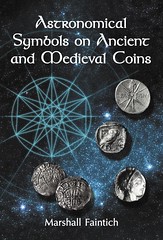 Last month we noted a recently published (2008) book on an unusual numismatic topic: Astronomical Symbols on
Ancient and Medieval Coins by Marshall Faintich.
Faintich lives in Central, Virginia, has a Ph.D. in astronomy, is a past national director of the American
Cartographic Association, and has been a numismatist for more than 50 years.
Last month we noted a recently published (2008) book on an unusual numismatic topic: Astronomical Symbols on
Ancient and Medieval Coins by Marshall Faintich.
Faintich lives in Central, Virginia, has a Ph.D. in astronomy, is a past national director of the American
Cartographic Association, and has been a numismatist for more than 50 years.
Me, I'm no expert on ancient and medieval coins, nor am I an astronomer. But I have recruited one to write a more nuanced review than I can provide. Kavan Ratnatunga has been reading the book, reviewing calculations, and jotting his thoughts. A regular E-Sylum participant, I met Kavan in Pittsburgh where he was an astronomer working at Carnegie-Mellon University and began attending meetings of the Pittsburgh Numismatic Society.
Kavan now lives in his native Sri Lanka and maintains an extensive web site on Sri Lankan coinage (www.lakdiva.org/). Look for Kavan's review later this summer. Meanwhile, here are my thoughts as a general reader and bibliophile.
If bibliomaniacs are a little crazy, authors must be crazier to invest so much of their time and life's energy into a book writing project. For most authors, it must be a passion. And so it was for Faintich, as he wrote in his Preface:
Writing this book has been a passion for me. Ancient and medieval numismatics, history, cartography, and astronomy are the foundations of this book... When I saw a figure of the 1290 denier of Edward II of Ponthieu, which depicts a crescent, an annulet, and then another crescent, my immediate thought was that it represented the phases of an annular eclipse. When I discovered than an annular eclipse actually did cross Ponthieu in 1290, I was hooked. From that moment on, the pieces of the puzzle began to come together, one coin at a time. (p1)
The result of Faintich's passion is a delightful reference for numismatists. I greatly enjoyed reading it, and I think others will, too. All it takes is our common love of history, some high school science and an appreciation for numismatics.
The book opens with an overview of astronomical symbols on coins throughout ancient and medieval times. The sun, moon and planets were often represented. Even the famous Athenean Owl includes a crescent moon image. Most of the book's coin illustrations are line drawings, and I think this is an excellent choice, for the drawings make very explicit design elements that can often be very hard to discern from photos.
For me, this part of the book ranks in importance with Tempus in Nummis, as coverage of an overarching theme that appears again and again in coinage. Numismatists are missing something if they study a particular series of coins without taking a step back to review overall themes and the context in which they fit.
Going far beyond the simple theme of celestial representation however, Faintich makes a very good case for tying particular coin issues to particular known celestial events such as the appearance of comets and lunar and solar eclipses.
The rarest and most spectacular event is a total solar eclipse, which I've never had the opportunity to experience. A solar eclipse in 585BC was reported to have "stopped the war between the Lydians and the Medes. During a battle in Northern Turkey, the two sides immediately stopped fighting when the eclipse occurred, and took the eclipse as a sign that they should make peace."
Then moments before totality, the shadow of the moon raced across the earth and darkened the sky as if a divine curtain had been pulled across the heavens.... and finally the magnificent solar corona became visible. During this process the temperature dropped by as much as 15oF. Wind currents changed. Animals became still and night creatures awoke. The planets and bright stars became visible.... those who had been mesmerized by the eclipse .. found themselves with permanent blind spots in their eyes. No wonder that ancient man took such rare sights as divine omens. (p33)
By correlating astronomical data with the appearance of related astronomical symbols on coins minted in the path of celestial events, the author proposes revised dates for the issuing sequence of coins such as those of Norman England. While the "precipitating event" of many coin changes is military or political (such as the Battle of Hastings or a ruler's coronation), others have a celestial trigger, such as the appearance of a comet, an alignment of planets or lunar or solar eclipse.
The author justly couches his conclusions as tentative. The final chapter, originally planned to be titled "Conclusions" is called "Beginnings". Here the author notes that much work remains to be done. I should note that I found the author's style and tone quite readable and matter-of-fact throughout. Facts are presented, hypotheses clearly labeled as such, and credit is given where due to others. I've seen too many scholarly books where the author's haughty know-it-all tone is so thick I could choke - this book is not one of them. Scholarly yes, but quite approachable.
Returning to the Preface, Faintich writes:
As I began to write this book, I thought I was writing a book about numismatics. By the time I finished, I had found that the book is much more than that. It is the basis for a new tool to explore and understand the political and mystical beliefs of ancient and medieval life. Thus I have not finished a book, but rather I have opened the door for more research. This is the passion: each new discovery answers one question, and at the same time asks another. Where will it lead? I do not know, but I invite you to join me on the journey."
The book is a very interesting journey of discovery, and for me it's a "keeper". There's nothing quite like it already in my library. Before closing I should add that it passes my "back of the book" test - there is a good five-page index, a four-page bibliography, and three appendices addressing the accuracy of analysis, additional examples of coins with astronomical symbols, and sources of figures. I'm curious to learn what Kavan and other reviewers have to say.
232 pages $55 hardcover (7 × 10)
566 illustrations, maps, appendices, bibliography, index
McFarland & Company, Inc., Publishers
Box 611
Jefferson, North Carolina 28640
336-246-4460
Orders 800-253-2187
FAX 336-246-4403
To read the earlier E-Sylum article, see: NEW BOOK: ASTRONOMICAL SYMBOLS ON ANCIENT AND MEDIEVAL COINS (www.coinbooks.org/esylum_v13n20a04.html)
THE BOOK BAZARRE
THE UNITED STATES BRANCH MINT AT DENVER, COLORADO TERRITORY
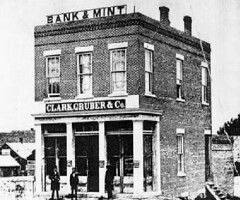 Regarding the question of how many different facilities the U.S. government has authorized to mint coinage, I can perhaps shed both light and darkness on what has thus far been called “the first Denver Mint” and “the Denver Mint of Clark, Gruber”.
Regarding the question of how many different facilities the U.S. government has authorized to mint coinage, I can perhaps shed both light and darkness on what has thus far been called “the first Denver Mint” and “the Denver Mint of Clark, Gruber”.
Officially, the “United States Branch Mint at Denver, Colorado Territory” opened for business September 24, 1863. It was the intent of Henry Gruber and the Clark brothers when they sold their company to the Treasury department that the government use the facility and equipment to mint gold coins on site. The facility was NOT just to be the assay office it eventually became. So what happened? And even more intriguing, is it possible the first Denver facility actually did strike coins?
The proof the government originally intended to strike coins at the Denver mint is demonstrable on many levels, from conception by the Clarks through the legislation authorizing the facility through subsequent parliamentary correspondence all the way to the name of the building itself: “United States Branch Mint”; the “…and Assay Office” was added later to give name to reality.
Additionally, many of Clark, Gruber's mint employees, including chief coiner George McClure, stayed on staff when the government took over the facility and trained them in minting operations. George Lane, the Denver Mint's first superintendent, urged Mint Director James Pollock as early as 1864 that the various problems besetting the mint would “be greatly modified if the law establishing this Branch Mint for the coinage of gold was put into execution” (that is, if they were allowed to mint gold coins as designed).
Despite the clear mandate to strike coins and all the equipment, training, staff and raw material positioned to put the plan into action, it seems to be generally accepted among numismatists that the original Denver mint did NOT strike coins; it only provided assay services for the local mining region.
Thus, the “first Denver mint” fails to make the list of those facilities actually minting U.S. coins. However, I wondered if this is just an argument from the negative: because there are no coins known from the first Denver mint, there must not have been any struck?
In researching the original Clark, Gruber & Co. minting facility at 16th and McGaa, including have access to the original minting machinery and unpublished photographs of the mint basement, I have had pause to reconsider the question. I believe there may be evidence: documentary, artifactual and circumstantial, that suggests the U.S. Mint may have indeed planned and even attempted to strike $20 coronet-head gold coins at the Denver Mint in 1864/5, only to have the operation be overcome by events, including Lincoln's assassination, a devastating fire and a technical snafu of the highest order.
For more details I am afraid the reader will have to wait for my long overdue book on Colorado gold coins based upon the unparalleled Frederick Mayer collection. I thus tentatively raise my hand and say, yes, the United States Branch Mint at Denver, Colorado Territory should be included on the exclusive list as a bona fide U.S. Mint. Stay tuned.
Photo 1: Presumed layout of Clark, Gruber & Co. basement coining room based upon contemporary descriptions and a series of photographs of the former mint building basement during demolition and excavation in 1980. (drawing by Deon Bahr, copyright 2009 Lawrence J. Lee)
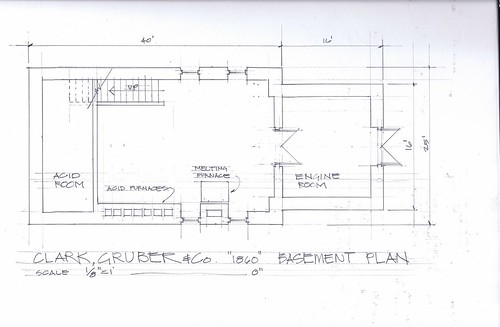
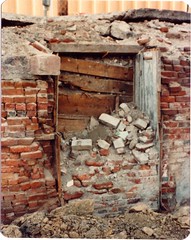 Photo 2: United States Branch Mint at Denver, Colorado Territory: southwest window of the basement coining room as revealed during excavations in 1980.
Both windows on this side of the building were open during the Clark, Gruber era but were bricked up when the entire facade of the building was changed in 1864.
Photo 2: United States Branch Mint at Denver, Colorado Territory: southwest window of the basement coining room as revealed during excavations in 1980.
Both windows on this side of the building were open during the Clark, Gruber era but were bricked up when the entire facade of the building was changed in 1864.
The mirror duplicate of the white limestone lintel in the window's upper left corner can be seen on the opposite (16th Street) side of the building in the famous photograph of the three proprietors standing in front of their mint. (Photo by Robert Pulcipher; copyright 2009 Lawrence J. Lee)
JUDGE JAMES P. GORTER MEDALLION FOUND
Russ Sears wrote:
I suspect that the two medallions which were made ended up in the family and are probably sitting in a drawer somewhere.
On Monday Kay O. Freeman wrote:
As a researcher, I would look at James P. Gorter's will, in Baltimore, to see if medallions are mentioned and whether bequeathed to institution or family. I would contact his descendents who I have found living in Illinois. Often, in my research, I have contacted descendents with good results.
Yesterday, Russ Sears wrote:
Kay Freeman's information hit the spot. Last evening I spoke with Mr. Thomas P. Gorter, Jr., the grandson of Judge Gorter. He has one of the medals. It is described as about 3" - 3.5" portraying the judge on one side and the presentation information on the other. Since it is framed and he is not scanner savvy, I didn't want to impose on him to go somewhere and have it photographed. Life is a treasure hunt.
To read the earlier E-Sylum article, see: QUERY: JUDGE JAMES P. GORTER MEDALLION SOUGHT (www.coinbooks.org/esylum_v13n25a17.html)
SHIP OF GOLD EXHIBIT TO DOCK AT BOSTON ANA CONVENTION
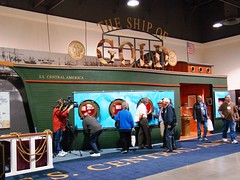 The incredible “Ship of Gold” exhibit, showcasing California Gold Rush-era sunken treasure recovered from the 1857 shipwreck of the SS Central America, will make port in Boston at the American Numismatic Association's World's Fair of Money, August 10-14 at the Hynes Convention Center. The exhibit is courtesy of Monaco Rare Coins of Newport Beach, Calif.
The incredible “Ship of Gold” exhibit, showcasing California Gold Rush-era sunken treasure recovered from the 1857 shipwreck of the SS Central America, will make port in Boston at the American Numismatic Association's World's Fair of Money, August 10-14 at the Hynes Convention Center. The exhibit is courtesy of Monaco Rare Coins of Newport Beach, Calif.
The SS Central America was recovered in 1988 from nearly 8,000 feet below the surface of the Atlantic Ocean. The ship sank in a hurricane in September 1857 while carrying California gold from Panama to New York City.
“There will be examples of historic assayers' ingots as well as San Francisco Mint and California territorial gold coins with a combined value of over $10 million,” said Adam Crum, vice president of Monaco. “One of the highlights is a huge Kellogg & Humbert ingot. Weighing just over 55 troy pounds, it is the largest surviving gold ingot of the California Gold Rush.”

The exhibit also includes one of the 13 recovered octagonal $50 gold pieces produced by the United States Assay Office of San Francisco, and the remains of a wooden cargo box that still contains approximately 110 Double Eagles as they were found on the ocean floor. Many appear to be 1857-S $20 gold pieces, apparently freshly struck at the San Francisco Mint when they were placed in the container for shipping.
Visitors will see the front pages of three 1857 newspapers that published stories about the shipwreck, the ordeal of survivors and the devastating economic effects created by the loss of the gold. Robert Evans, the chief scientist on the 1980s mission by the Columbus-America Discovery Group that located and recovered the magnificent sunken treasure, will be in Boston to meet visitors and discuss the SS Central America, her cargo, crew and passengers.
I've thought a lot lately about the recovery of the Central America treasure, because the flailing efforts of oil engineers to cap the spewing BP well illustrate how incredibly difficult it is to work as such ocean depths. I learned a lot by reading the Ship of Gold book and other books on the Central America salvage effort. It took a lot of technology, hard work, and brainpower to discover the wreck and recover coins and artifacts from water so deep the pressure would kill a man instantly. Robots and remote-control vehicles are the only way to do it. -Editor
PUBLICATIONS OF THE COIN AND CURRENCY INSTITUTE
One E-Sylum reader writes:
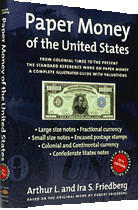 I couldn't resist answering the query you posed. The Coin and Currency Institute was the publishing arm of Capital Coin Co., the department store coin firm founded by Robert Friedberg, and run for many years after Robert's death by his brother Jack and widow Goldie. I believe the firm is currently owned by Robert's sons Arthur and Ira, and managed by Arthur.
I couldn't resist answering the query you posed. The Coin and Currency Institute was the publishing arm of Capital Coin Co., the department store coin firm founded by Robert Friedberg, and run for many years after Robert's death by his brother Jack and widow Goldie. I believe the firm is currently owned by Robert's sons Arthur and Ira, and managed by Arthur.
As you probably know, the most familiar titles bearing C&C's imprint are 'Paper Money of the United States', and 'Gold Coins of the World', both of which have had many editions over the years.
David Gladfelter writes:
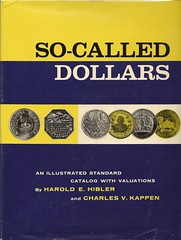 Most will get Robert Friedberg's series on U. S. paper money and gold coins of the world. Token and medal collectors will get Hibler and Kappen. Colonial collectors will get Schilke and Solomon. And if you look on the back of the first book you will see advertised the title Appraising and Selling Your Coins. They also published Friedberg's book on British Commonwealth coins. Which two am I missing?
Most will get Robert Friedberg's series on U. S. paper money and gold coins of the world. Token and medal collectors will get Hibler and Kappen. Colonial collectors will get Schilke and Solomon. And if you look on the back of the first book you will see advertised the title Appraising and Selling Your Coins. They also published Friedberg's book on British Commonwealth coins. Which two am I missing?
Pete Smith writes:
The Coin and Currency Institute has a website where they offer eight books for sale. That is too easy to justify as the answer to an E-Sylum quiz answer.
- Paper Money of the United States
- Gold Coins of the World
- Coins of the British World
- Appraising and Selling Your Coins
- So-Called Dollars
- America's Foreign Coins
- Current Coins of the World
 But this list of eight does not match the eight on the web site (see
www.coin-currency.com/book.html
) Also listed are:
But this list of eight does not match the eight on the web site (see
www.coin-currency.com/book.html
) Also listed are:
- The Investor's Guide to United States Coins by Neil S. Berman & Silvano DiGenova
- The Early Dated Coins of Europe, 1234-1500 by Robert A Levinson
- De Nederlandse Munten van 1795 to Heden (Dutch Coins from 1795 to Date). By Johan Mevius
- The South African Coin and Banknote Catalog 1998-1999. By Cliff van Rensburg.
The first two were published by the Coin & Currency Institute. The web site doesn't say who published the last two. -Editor
American Numismatic Society Librarian Elizabeth Hahn writes:
I was reading through The E-Sylum and was intrigued by your quiz asking for the names of at least 8 numismatic books published by the Coin & Currency Institute, Inc. As a short promotion for the ANS Library, I'd like to say that the answer can be found through a quick search of the new library catalog, Donum!
We are still doing some technical maintenance to the new catalog, and some design changes will be appearing in the next 2-4 weeks, but otherwise I would encourage readers to take advantage of this ANS Library resource and this quiz is a great way to see the improved searching (and sorting) capabilities of the new catalog.
Here's the list that I came up with after a 2 minute search for "coin and currency institute":
Publisher: Coin and Currency Institute, Inc.
- Paper money of the United States : a complete illustrated guide with valuations (various editions).
- Appraising and selling your coins. A complete, illustrated catalogue of U.S. coins and bills and their cash premium values from 1652 to the present (various editions)
- Coinage & conflict
- International coin catalogue and price list
- Gold coins of the world, complete from 600 A.D. to the present : an illustrated standard catalogue with valuations (various editions)
- A catalog of modern world coins, 1850-1964
- The investor's guide to United States coins
- Current coins of the world
- So-called dollars : an illustrated standard catalog with valuations
- America's foreign coins : an illustrated standard catalogue with valuations of foreign coins with legal tender status in the United States, 1793-1857.
- The Early dated coins of Europe, 1234-1500 : an illustrated catalogue and guide to dated medieval coinage
How did I do? Or rather, how did the catalog do?
- Coinage & conflict
- International coin catalogue and price list
This is a relatively small number of titles for such a long history of publishing, but several of these are landmarks in the hobby. The Friedberg Paper Money book was the classic reference for decades and is still popular. The So-Called Dollars book was probably a commercial flop at first, with many unsold copies. Yet over the years it became the standard reference in that field, with the price of the book rising greatly once out of print.
America's Foreign Coins is one of my favorite books, and it was one of the first on my shelf of colonial coin references. My copy was inscribed to Lee Hewitt by coauthor Oscar Schilke. This book was probably no blockbuster either, but again, very important to the hobby. Kudos to C&CI for making so many great references available. -Editor
To read the earlier E-Sylum article, see: THE LIBRARY OF COINS ALBUMS AND THE COIN AND CURRENCY INSTITUTE (www.coinbooks.org/esylum_v13n25a18.html)
NUMISMATIC VOCABULARY: BORDERS, RIMS AND EDGES
I cataloged a medal this week that brought to mind the differences between borders, rims and edges, three terms in numismatics that are often confused.
The medal at hand had a medium wide rim on the reverse for a very unusual purpose - it was intended for inscribing the recipient's name. The obverse bore a scene of a female placing a wreath on a male youth's head. The reverse bore the logo of the sponsoring firm, Diamond Match Company.
That wide rim had a cartouche stretching around two-thirds of the top circumference of the medal, with tiny ornate ends of the cartouche. It was almost as if the artist, Frederick Ziegler, had widened the rim and added the cartouche ends as an afterthought. It's the only one like this I have ever seen (of perhaps 50,000 medals I have cataloged).
Rims vary in width. They are usually narrow and flat. A very narrow rim is called a lip, a very wide rim is called a cartwheel rim (named after the British two-pence of 1797). Such a wide rim invites medal designers to add lettering, which often happened. Instead of being flat, rims can also have a bevel, called oblique. Such an oblique rim is a diagnostic of a Canadian medal maker, Lombardo Mint - all their medals have sloping rims.
But the most unusual rims of all were created by a British diesinker in the 1880s, J.A. Restall, who placed rays on top of the rims of the medals he created, an unusual mannerism, and diagnostic of this engraver. Almost like reeding on top of his medium wide rims.
The rim is the outermost element of the border. The border can be made of many elements, and the larger the medal the more opportunity for multi-element borders. They have several functions -- borders act as a frame for the design within -- they draw the viewers' eyes inward to the device and lettering. They also have a utilitarian function, particularly for multi-element borders on large medals: they help human fingers hold on to the medal. The tiny ridges of your fingerprint, the whorls and loops lock into the open areas between the ridges of the border elements. (Laugh if you wish – it's true!)
Border elements have many names. A row of dots are called beaded (French, grenetis). A simple line is linear, often among a succession of planes and arcs. A molded border is made from a template when the medallist is beginning the design in clay, before transferring the design to plaster. Repeated spiked or tooth-shaped elements are called dentiles, and the border can be called dentilated. Or a border could be formed of a rope-shaped element called corded. The medal designer has a wide choice of border elements to frame his design.
The border and rim extends to the outer perimeter of the obverse or reverse surface, to the very drop-off point of the edge. I searched for years for a name of that point. I found none, so I came up with one, the rim-edge juncture. You don't need to look that up in a dictionary, you know exactly what it means.
That rim-edge juncture is very important in proof surface coining, as a pressman attempts to control the pressure of the coining press so metal of the blank fills every cavity in both dies, and forms the reeding in the collar if any, plus flowing to form a perfect point at the rim-edge juncture. If the metal goes beyond that point it squeezes out (between die and collar) to form a wire edge (British, knife edge). In metalworking that excess material is called flash.
Edges can be given many surfaces as well. Coins and medals struck inside a collar can be smooth or reeded depending upon how the collar wall was made -- both can be ejected from the collar after striking. The reeding or knurling consist of open areas, flutes, alternating between raised projections, knurls.
Since not all medals are struck inside collars, but struck with open-face dies (British box dies) their edges must be trimmed of that excess material flash, squeezed out from between the dies. Once this is done any number of things can be done to the edge of medals. They can be beveled, rounded, polished (please don't--a super smooth edge hastens dropping the medal), and of course, lettering, hallmarking or such.
Hope that helps eliminate any misuse of these terms.
RERUN: HISTORY DETECTIVES TACKLE PURPORTED ANNIE OAKLEY COIN
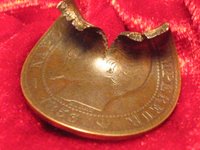 Meadow Merrill has an intriguing "either/or" coin-related scenario. She owns an 1853 5 Centimes bronze coin from France that is either a worthless, damaged piece of junk, or a valuable and historically important artifact from the Wild West. The coin, which features a portrait of Napoleon III, is a family heirloom that has been passed down to Merrill with an interesting story. It was purportedly shot up by legendary Wild West sharpshooter Annie Oakley! Is there any way to authenticate such a coin?
Meadow Merrill has an intriguing "either/or" coin-related scenario. She owns an 1853 5 Centimes bronze coin from France that is either a worthless, damaged piece of junk, or a valuable and historically important artifact from the Wild West. The coin, which features a portrait of Napoleon III, is a family heirloom that has been passed down to Merrill with an interesting story. It was purportedly shot up by legendary Wild West sharpshooter Annie Oakley! Is there any way to authenticate such a coin?
Like most coins that have legends attached to them, the potential monetary value of the coin is closely tied to the ability to verify the claims made about it. Annie Oakley was known to have shot at coins thrown into the air, usually putting a bullet clean through them. But is there any way to prove that any given coin with a bullet hole through it was one shot by Oakley? Finding out the answer in Merrill's case proves to be an excellent exercise in numismatic forensics, which is why I am sharing it with you.
Merrill inherited the coin, along with some photographs depicting musicians and performers in the famous Buffalo Bill Cody's Wild West Show. Family lore claimed that Annie Oakley gave the coin to Merrill's great-grand uncles, who were purportedly musicians in the Wild West troupe. The PBS show History Detectives sent investigator Elyse Luray to attempt to verify the story. During her investigation, Luray takes the following steps:
Compare the photos to known Wild West images - Luray visits the Buffalo Bill Historical Center in Cody, Wyoming, to do some checking. The Center has extensive archives and artifacts from the Wild West Show and Annie Oakley. Do the photos match? Are Merrill's photos what she thinks they are? Are her relatives in any of the Historical Center's photos?
Set up a test shoot using a similar coin and Oakley's favorite gun - Luray tacks a similar coin onto a target board and has a sharpshooter hit the coin. Then she compares the marks the bullet left on the coin. Do the marks match those on Merrill's heirloom coin?
Consider some common sense - Would a 5 Centimes coin from France likely show up in late-19th century America? Or did Annie Oakley ever travel to France? In other words, is an 1853 5 Centimes French coin likely to have ever come into Annie Oakley's hands?
Scientific forensic analysis - Can the modern science of ballistics tell us anything about whether the coin was even really damaged by a bullet? And if it was, what type and kind? Is this a bullet from a gun type that Annie Oakley could have used?
Genealogical research - Can Merrill's family members be traced back into time, and proven to have been part of the Wild West troupe? (This part of the show is really good; Investigator Luray offers some excellent tips for performing your own genealogy research!)
Did Annie Oakley Shoot the Coin?
All of the above analysis is carried out at a slow, easy-to-follow pace during the show. Investigator Luray cannot say for 100% certainty that the coin was shot up by Annie Oakley, (after all, short of having a video or fingerprints on the coin, how could you prove something like that,) but given the Merrill family photographs and the fact that Merrill's ancestors were part of the Wild West Show troupe, it is extremely likely that the story about the coin is true.
To read the complete article, see: Did Annie Oakley Really Shoot This Coin? (coins.about.com/od/famousrarecoinprofiles/qt/annie_oakley.htm)
To read the earlier E-Sylum article, see: TV'S "HISTORY DETECTIVES" EXAMINE COIN SHOT BY ANNIE OAKLEY (www.coinbooks.org/esylum_v11n27a20.html)
THE BOOK BAZARRE
CHARLOTTE BRANCH MINT INFORMATION IN THE 1913 MINT REPORT
Dave Ginsburg writes:
I am writing to slap you upside the head for using a secondary source when you had a primary source at your fingertips!
In last week's edition of The E-Sylum, you quoted a portion of page 147 of Anthony Stautzenberger's excellent book The Establishment of the Charlotte Branch Mint: A Documented History. As you (should) know, that portion of Mr. Stautzenberger's book was, in fact, extracted from the very nice history of the Charlotte Mint that appeared in the Mint Director's Annual Report for the Fiscal Year ended June 30, 1913. If one would like to read the entire history, instead of an extract, it's available, through the good graces of Google Books, here: Annual report of the Director of the Mint .
Although Google Books certainly doesn't need me to toot their horn, it really is an excellent source of original 19th and early 20th century material (including the Annual Reports of the Secretary of the Treasury, Comptroller of the Currency, Director of the Mint, etc.) in easy to search and store digitized form.
So, don't make me hurt you again - use an original source!
To read the earlier E-Sylum article, see: MORE ON THE VARIOUS U.S. MINT BUILDINGS (www.coinbooks.org/esylum_v13n25a12.html)
QUERY: TOTAL NUMBER OF DIFFERENT REGULARLY MINTED U.S. COINS
Duane H. Feisel writes:
Does anyone have a count of the total number of different United States coins regularly minted? This would include all denominations, designs, dates, mint marks, compositions and the like, but would exclude patterns, trials, proofs and the like. Perhaps someone already has this information before I sit down with a Red Book and start counting.
MORE BASHLOW CONFEDERATE COIN RESTRIKE SIX-COIN SETS
Not only do I have one of these sets, but also the papers that go with it. According to the papers, these “restrikes” are more technically the “second restrikes” since John W. Haseltine restruck 74 of the cent pieces in 1874, and J. W. Scott restruck 500 of the half dollar pieces circa 1879.
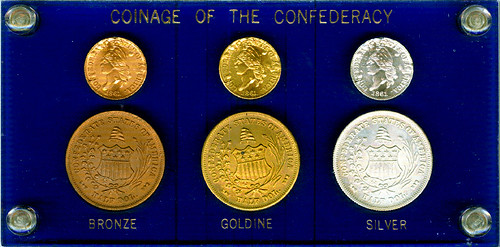
Perhaps “copies” would be an even more correct term, since while the “first restrikes” were in fact made from original dies, these dies by 1962 were too deteriorated for further striking use, so copy dies were made from them to produce the “second restrikes”.
The “second restrikes” of both denominations were made by August C. Frank & Co., Philadelphia, to the order of Robert Bashlow during the Civil War centennial in 1962. They are not rare as individual pieces. According to the brochure, 5,000 pieces of both the cent and half dollar were struck in silver, a like amount in “goldine” (a brassy alloy developed for token planchets by the Osborne Coinage Co. in the 1930s), and 20,000 pieces of each of the denominations in bronze. These figures agree with those given by Walter Breen in the Complete Encyclopedia (cent only, Nos. 8011, 8014 and 8013 respectively).
Some of these pieces were put up in sets housed in “official holders” like the set shown in The E-Sylum. “Special offer,” the brochure said. “We are making the beautiful Official Lucite Holder illustrated above available to all who purchase the Confederate Half Dollar now (italics in original). This offer will not be good after the Half Dollar is advertised to the public, when the holder will sell for $2.00.” The silver pieces were priced at $7.50 each, the bronze at $2.50 each and the goldine at $4.50 each, making the cost of the set in the holder $31.00. The brochure does not state how many sets in holders were produced.
I had some correspondence about the Bashlow restrikes with Q. David Bowers circa 1988. He wrote about them in his column, Coins & Collectors, in The Numismatist 101:1059 (June 1988).
Scott Rubin writes:
I have one of the six coin sets of Bashlow's Confederate coins.
Jonathan Brecher writes:
Those six-coin Bashlow sets turn up on eBay from time to time. There was one "recently" -- maybe about 3 months ago. One of the current authorities seems to be Tom Jankovsky.
To read the earlier E-Sylum article, see: QUERY: BASHLOW CONFEDERATE COIN RESTRIKE SIX-COIN SETS (www.coinbooks.org/esylum_v13n25a15.html)
RICHARD MARGOLIS ON THE CHASE MANHATTAN MONEY MUSEUM
Regarding the photo submitted last week by Gene Hessler, Richard Margolis writes:
Most interesting to see Vernon Brown surrounded by a large group of eager young coin enthusiasts circa 1945. I am not among them, although I did indeed know Vernon, and visited the Chase Manhattan Money Museum a couple of times, including many years later when Gene Hessler was in charge.
At the time, I had a single coin collecting friend, Henry Kotzen. Both of us lived on the upper west side of Manhattan, and on Saturday mornings we would walk down to Stack's, at 12 West 46th Street. I still well remember the pained expression on Ben Stack's face once when he saw us coming in the door while an auction was being conducted.
I remain as interested in numismatics as ever and just returned a couple of days ago from France (my 142nd overseas trip!), where I finally completed some research in Paris and three other towns. I expect to attend the Boston ANA Convention, not with a bourse table, but, time permitting, will exhibit my early Benjamin Franklin medals and medallions.

To read the earlier E-Sylum article, see: QUERY: CHASE MANHATTAN MONEY MUSEUM VISITORS CIRCA 1945 (www.coinbooks.org/esylum_v13n25a11.html)
1794 DOLLAR OWNER MARTIN LOGIES INTERVIEWED
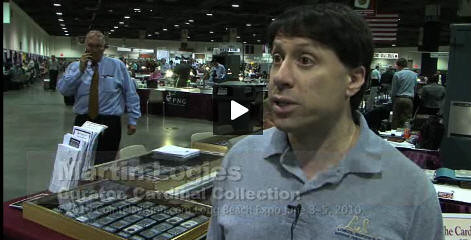
It was sold by Steven L. Contursi, President of Rare Coin Wholesalers of Irvine, California, to the nonprofit Cardinal Collection Educational Foundation (CCEF) in Sunnyvale, California. Collector and numismatic researcher Martin Logies represented the foundation of which he is a director and its numismatic curator. The private sale was brokered by Greg Roberts, President and Chief Executive Officer of Spectrum Group International of Irvine, California.
From 2004 to 2009, the coin was a featured exhibit at the American Numismatic Association's Edward C. Rochette Money Museum in Colorado Springs, Colorado, and was displayed at a half dozen ANA World's Fair of Money and National Money Show conventions around the country.
The 1984 Stack's auction lot description in the Carter Collection sale stated, “It is perfectly conceivable that this coin was the very first 1794 Silver Dollar struck!” Over the decades, various numismatic researchers have stated a similar belief including Walter Breen, Jack Collins, John Dannreuther, David Hall and Logies who is author of the book, The Flowing Hair Silver Dollars of 1794.
David Lisot of CoinTelevision.com interviewed both the buyer, Martin Logies, Curator Cardinal Collection Educational Foundation and the seller, Steve Contursi, President of Rare Coin Wholesalers at the Long Beach Expo earlier this month.
To read the complete article, see:
Video: Interviews with Martin Logies and Steve Contursi on the Sale of the 1794 Silver Dollar
(www.coinlink.com/News/uncategorized/video-interviews-with-martin-logies-and-steve-contursi-on
-the-sale-of-the-1794-silver-dollar/)
Richard Margolis writes:
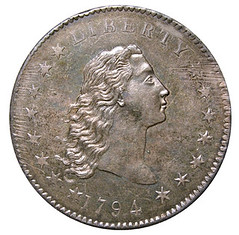 I have always felt that the prominent adjustment marks on the flan of the recently sold, albeit remarkably preserved, 1794 silver dollar eliminated the possibility of its being the first example struck. Surely a perfect flan would have been used if there was any intention at the time of creating a special initial striking.
I have always felt that the prominent adjustment marks on the flan of the recently sold, albeit remarkably preserved, 1794 silver dollar eliminated the possibility of its being the first example struck. Surely a perfect flan would have been used if there was any intention at the time of creating a special initial striking.
To read the earlier E-Sylum article, see: BILL ECKBERG ON THE NEIL-CARTER 1794 DOLLAR (www.coinbooks.org/esylum_v13n25a20.html)
SO WHAT IS THIS STRANGE 'GOOD LUCK' SYMBOL?
Tom DeLorey
The mysterious "good luck symbol" appears to be a series of geometric figures, including a square, a triangle and a parallelogram, plus some other things I cannot make out in the tiny picture. I have no idea why they would collectively be considered a good luck symbol.
Joe Boling writes:
It looks like an Egyptian hieroglyph to me.
Arthur Shippee and Martin Purdy agree. Martin writes:
The bottom-left element looks to be made up of three separate elements. While I'm no expert in the field, I would hazard a guess that they're Egyptian hieroglyphs. What they spell out is beyond me, though
In your June 20 E-Sylum you and Stuart Williams asked about the symbol on a token. I recognized that this design also appears (in reverse) on another 1915 token, for the Panama-California Exposition of 1915-16 in San Diego.
This is on the reverse of the Home Economy Building So-Called Dollar, cataloged by Hibler & Kappen as HK-433 in their So-Called Dollars book. They describe the reverse as "Swastika containing 4-leaf clover, horseshoe, wishbone and 3 other good luck emblems; below Good Luck; above, around Membership Emblem of the Dont (sic) Worry Club." Evidently they didn't know what the "3 other good luck emblems" were either.
I Googled "Don't Worry Club" and was led to a Boy Scout leader's website named "World Scout Coins" at www.sageventure.com/coins/worry.html which shows dozens of similar designs, also this description of the symbols in "Three runic symbols in quadrant 4":
 "Runic Symbols. Runes are an alphabetic script used by the people of Northern Europe from the first century c.e. until well into the Middle Ages. In addition to their use as a written alphabet, the runes also served as a system of symbols used for magic and divination." (The Runic Journey by Jennifer Smith, 2003.).
"Runic Symbols. Runes are an alphabetic script used by the people of Northern Europe from the first century c.e. until well into the Middle Ages. In addition to their use as a written alphabet, the runes also served as a system of symbols used for magic and divination." (The Runic Journey by Jennifer Smith, 2003.).
"Hence, like the other symbols of luck these runic symbols are of superstition. The three runic symbols that I believe may be the symbols on the tokens stand for: protection, mother goddess, and home and family unity. If you have more information, please email me.
"These three symbols are slightly different than today's standardization of them but I feel it is due to variation in character drawings in the same manner as we all write differently."
He must be correct - it's written on the Internet!
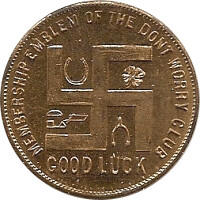
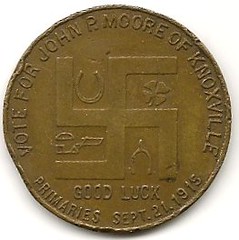
Pete Smith is still skeptical. He writes:
Many tokens have good luck symbols similar to the John P. Moore token mentioned in The E-Sylum. I am more familiar with the Excelsior Shoe Company tokens associated with Boy Scout tokens. I found several web sites that identify the mystery symbol. Explanations include:
1. Food
2. Native American symbols
3. Runic symbols for protection, mother goddess, home and family unity
In my opinion, none of these are correct. I see a square, triangle, parallelogram, and semi-circle. I haven't figured out how these represent good luck. I also discovered the web site mentioned by Gar Travis. I then did some research on Runic symbols and could find nothing that corresponded to the symbols on the token.
To read the earlier E-Sylum article, see: QUERY: WHAT IS THIS STRANGE 'GOOD LUCK' SYMBOL? (www.coinbooks.org/esylum_v13n25a27.html)
NOTES FROM E-SYLUM READERS: JUNE 27, 2010
Last week, Dick Doty of the National Numismatic Collection wrote:
Regarding the Diana Gambling token, it seems to me that a token is defined as a substitute for ‘real' money. As such, it will be made from a lesser or at least different material than the money whose substitute it is intended to be. Why would anyone create a gambling chip of the same size, weight, and material as the coin it's intended to replace?
Duane H. Feisel writes:
What about all the Civil War tokens? Many Civil War tokens were made in copper the same as cents, and a number of them contained more metal than a US cent.
Last week Dick Johnson wrote:
I am waiting for Dick Hanscom to get so frustrated with his home minting kit that he is going to throw something against the wall.
Dick, take your die to a professional private mint and have them strike it for you. They will know what to do and have the proper equipment to do it. I just hope you haven't received your mail order home heart surgery kit yet.
Dick Hanscom writes:
I just read The E-Sylum and Mr. Johnson's comments. While I was not laughing out loud, I was grinning from ear to ear. He obviously has me confused with someone who is trying to do this on a serious basis. By the way, does he have an address for that “home heart surgery kit?” I do have high cholesterol and I could save a bundle doing my own bypass.
I am not trying to duplicate the quality products of a real mint. I don't even call it a mint, just a workshop. I am just having fun, learning a little along the way, and trying not to hurt myself.
I am planning on being at the ANA in Boston. I hope Mr. Johnson is there. I would like to meet him. I did a little business with him years ago when he was with Johnson & Jensen. Perhaps I can put his mind to rest that I am not a serious threat to the well being of numismatic art.
The whole point of the project is to have fun. And E-Sylum readers have been a great help for which I thank them.
To read the earlier E-Sylum article, see: MORE ON COIN STRIKING TECHNOLOGY (www.coinbooks.org/esylum_v13n25a19.html)
Regarding the current profusion of electronic books discussed in the article Harry Waterson forwarded, Jon Radel writes:
In some ways I find even more irritating the "books" which have every appearance of being printouts of Wikipedia articles, but, naturally never mention this. See, I suspect, Commemorative Coins of the United States: Modern United States Commemorative Coins, 50 State Quarters, Columbian Exposition Half Dollar, by Books LLC (Creator), as sold on Amazon.com. The description is very close to excerpts from Wikipedia, and, "purchase includes free access to book updates online." I'm not curious enough to spend $19.99 to confirm my suspicions.
Someday, though, I might work my way up to spending $14.14 for a copy of the blockbuster, Economy of Zimbabwe: Economy of Zimbabwe, Zimbabwean Dollar, Banknotes of Zimbabwe, Zimbabwe Industrial Index, Zimbabwe Stock Exchange by the same publisher, if only to see if it's printed on nice paper.
Of course, all of this is a pretty obvious result, in retrospect at least, of the print-on-demand technology combined with Amazon.com's willingness to market anything legal for anybody. Worrying about whether you'll sell enough copies to cover the editorial efforts, and the costs of the initial press run, is just so old school.
To read the earlier E-Sylum article, see: TRUTH IN LABELING NEEDED FOR PRINT ON DEMAND LISTINGS (www.coinbooks.org/esylum_v13n25a22.html)
THE BOOK BAZARRE
LOREN GATCH ON BIG GOLD COINS
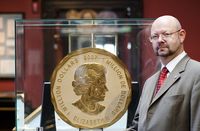 There is an auction taking place June 25 of the largest gold coin in the world-. This $1 million dollar Canadian hubcap weighing some 100 kilos. Here's a link to a video on the upcoming sale:
finance.yahoo.com/video/investing-18773139/
There is an auction taking place June 25 of the largest gold coin in the world-. This $1 million dollar Canadian hubcap weighing some 100 kilos. Here's a link to a video on the upcoming sale:
finance.yahoo.com/video/investing-18773139/
world-s-biggest-gold-coin-for-sale-20401685
.
Interestingly, the Austrian firm possessing this symbol of financial stability went bankrupt amidst allegations of fraud.
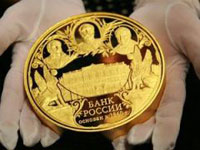 Just earlier this year the Russians put out a 50,000 Ruble gold coin, weighing a mere five kilos:
english.pravda.ru/business/finance/19-05-2010/113435-bank_of_russia-0
.
Just earlier this year the Russians put out a 50,000 Ruble gold coin, weighing a mere five kilos:
english.pravda.ru/business/finance/19-05-2010/113435-bank_of_russia-0
.
Twice this size is the Chinese 100,000 Yuan, issued at the time of the Beijing Olympics.
While you won't find this stuff on the Island of Yap, they are still pretty impressive and, I think, an apt counterpoint to our current global financial turmoil.
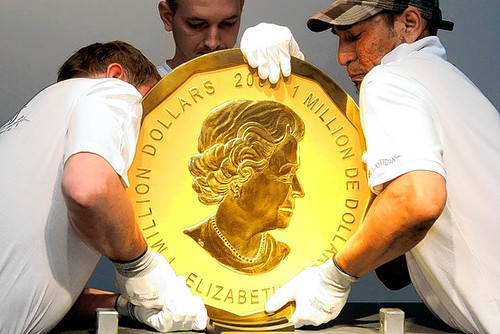
A 220-pound gold coin, roughly the size of a car wheel, was sold at auction to Spanish trading firm Oro Direct for €3.27 million ($4.03 million), essentially equal to the spot price of gold.
The Maple Leaf, made by the Canadian Mint in 2007, has a face value of one million Canadian dollars (US$964,000).
In the end, there was just one bidder for the coin, on the block as part of the bankruptcy of an Austrian investment firm, and the buyer wasn't willing to pay up for the coin's unusual size.
Oro Direct, a Spanish gold-trading firm, met the auctioneer's opening price of €3.27 million ($4.03 million) for the coin, a 100-kilo (220-pound) pure gold coin that is the size of a car wheel, essentially equal to the spot price of gold. Eight potential bidders had been registered at auction house Dorotheum, the world's oldest auction house, but only Oro Direct raised its hand.
The auction price disappointed Michael Beckers, Dorotheum's coin expert who oversaw the sale. He had predicted that the price could go as high as €4 million "on a good day."
"I'm a little disappointed. I had hoped and expected to achieve more," he said, minutes after the hammer fell.
As the auction began, gold was selling for €1.011.89 per troy ounce, so 100 kilos of gold was worth €3.25 million, or $4.02 million. That means Oro Direct barely paid a premium for the coin, one of five in the world. It was the first time one of the coins had been sold.
To read the complete WSJ article, see: Giant Gold Coin Sells for $4 Million (online.wsj.com/article/SB10001424052748703615104575328613899215820.html)
To read the earlier E-Sylum article, see: THE WORLD'S LARGEST GOLD COIN TO BE AUCTIONED (www.coinbooks.org/esylum_v13n25a29.html)
WHY CHINA'S CURRENCY HAS TWO NAMES: YUAN AND RENMINBI
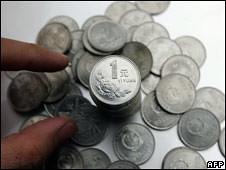 China has indicated that it will allow its currency to appreciate - following months of pressure from the US. Some refer to the currency as the yuan, others call it the renminbi. Who is right?
China has indicated that it will allow its currency to appreciate - following months of pressure from the US. Some refer to the currency as the yuan, others call it the renminbi. Who is right?
In colloquial speech the yuan has other names too Both names are perfectly good, but in slightly different ways.
"Renminbi" is the official name of the currency introduced by the Communist People's Republic of China at the time of its foundation in 1949. It means "the people's currency".
"Yuan" is the name of a unit of the renminbi currency. Something may cost one yuan or 10 yuan. It would not be correct to say that it cost 10 renminbi.
An analogy can be drawn with "pound sterling" (the official name of the British currency) and "pound" - a denomination of the pound sterling. Something may cost £1 or £10. It would not be correct to say that it cost 10 sterling.
Nor can you talk about the number of renminbi - or the number of sterling - to the dollar.
The word "yuan" goes back further than "renminbi". It is the Chinese word for dollar - the silver coin, mostly minted in the Spanish empire, used by foreign merchants in China for some four centuries.
The Chinese phrase for the US dollar is "mei yuan", the American yuan. The Japanese and Korean names for their currencies, the yen and the won respectively, are derived from the same Chinese yuan character.
As it happens, Chinese people rarely talk about renminbi or yuan.
A fistful of kuai The word they use is "kuai", which literally means "piece", and is the word used historically for coins made of silver or copper.
Also common is "10 kuai qian", literally "10 pieces of money".
"Kuai" is colloquial, like "quid" in the UK and "buck" in the US, but it is the word used in everyday Mandarin, whether you are in Beijing or Taiwan - which, of course, has its own currency, the new Taiwanese dollar, also known as the yuan.
To read the complete article, see: Why China's currency has two names (news.bbc.co.uk/2/hi/world/asia_pacific/10413076.stm)
WHY NAILS ARE MEASURED IN PENNIES
Have I mentioned that the guy who built my house also owned a lumber yard? My door and window trim is two by sixes. You know, like the stuff they use for decking. And being from 1905, it's really two inches by six inches, not the one and a half by five and a half of the modern two by six. Ponder for a moment what size finishing nail would be required to hold something two inches thick to the wall, and you will begin to see my dilemma- you need a nail about four inches long.
Let me digress briefly into the lore of nails. The round, chisel pointed wire nail with which we are familiar dates to around the 1850s, when wire nail-making machinery was invented in France, making it possible to turn out zillions of nails in a short time for a low price. Nails used for attaching wood to other pieces of wood are classified using the term “penny” along with a number representing the length; for instance, a nail 3-1/2 inches long is known as a sixteen-penny nail. A 2-1/2 inch nail is known as a six-penny nail. Why? Supposedly in medieval England, you could buy a hundred 3-1/2 inch nails for 16 pence (pennies), whereas you could get a hundred 2-1/2 inch nails for only 6 pence. Thus, the shorter the nail, the smaller the number. Why then, one might ask, does it says 16d on the box and not 16p? Well, because they used the name of a Roman coin, the denarius. No, I don't know why.
To confuse things further, nails not necessarily used for attaching wood to more wood (like roofing or siding nails) are referred to in inches rather than penny sizes.
Finishing nails are nails that are essentially “headless”, having merely a sort of bulge at the top- they are meant to be driven below the surface of the wood, and the hole filled with putty. They are thinner than regular nails as well. Finishing nails for normal trim would be 6d or 8d.
To read the complete article, see: Restoration Comedy:Nail Salon (www.berkeleydailyplanet.com/issue/2010-06-22/article/35669?headline=Restoration-Comedy-Nail-Salon)
FEATURED WEB SITE: UNIVERSITY OF VIRGINIA NUMISMATIC COLLECTION
This week's Featured Web Site is the University of Virginia Art Museum Numismatic Collection.
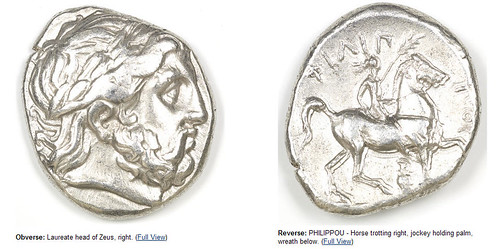
The University of Virginia Art Museum houses nearly 600 coins of Greek and Roman origin. The coins were generally acquired in small lots that were purchased or donated from 1987-2001, but larger groups of coins belonging to English hoards were also acquired, including 51 from the Normanby Hoard and 302 from the Oliver's Orchard Hoards. About 450 of the total number of coins are from the Roman Republic or Empire, providing a broad sample of coins from the late 3rd century B.C. to the late 3rd century A.D., particularly from the Crisis of the Third Century--including more than 100 coins from the breakaway Gallic Empire of A.D. 260-274.
coins.lib.virginia.edu

